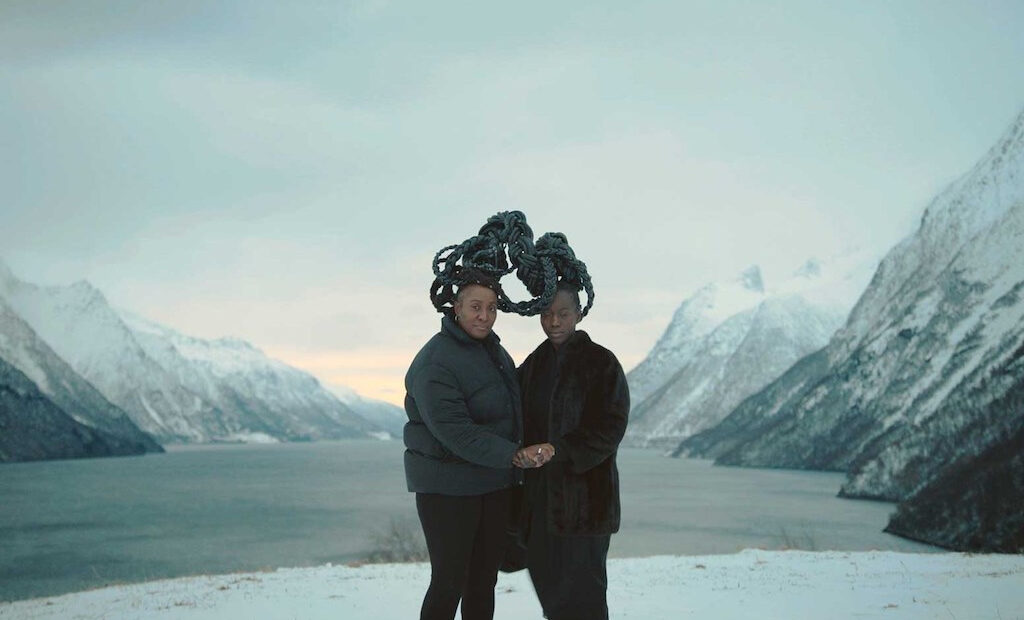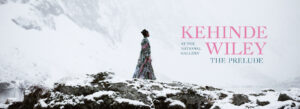Kehinde Wiley: The Prelude at the National Gallery

African American artist Kehinde Wiley is arguably best known for his 2018 portrait of Barack Obama. The first Black artist to be commissioned to paint an official portrait of a US president, he depicted Obama seated in front of green foliage bursting with multicoloured blossoms, referencing the politician’s Hawaiian birthplace and Kenyan roots. Now the National Gallery plays host to his first exhibition at a major British institution – Prelude, named after William Wordsworth’s great autobiographical poem. The artist casts his eye over the sublime landscapes and seascapes of the Romantic period in a show featuring five paintings and a six-channel digital film.
A keen student of art history, the young Wiley would visit the Huntington Library and Botanical Gardens collection in San Marino, California, which boasts a strong collection of British portraiture, including Gainsborough’s Blue Boy. He has become internationally recognised for his portraits that show contemporary people of colour in the settings of Old Master paintings such as his reworking of Hans Holbein the Younger’s The Ambassadors, featuring fellow African American artists Sanford Biggers and Rashid Johnson. Over the years, the artist has selected unknown models for his paintings from the streets of the US, Senegal and now London.
For the present exhibition, Wiley has changed the focus from his well-trodden path of European portraiture to landscape painting. Again one finds the artist transposing contemporary people in the paintings of the past. Two canvases are recognisable reworkings of Caspar David Friedrich’s Wanderer Across the Sea of Fog (1818) and Chalk Cliffs on Rügen (1818). The scale of Wiley’s paintings mark them out from the originals, with the 18th century’s artist’s masterpieces measuring under a metre and the American’s, a lofty four. Wiley’s painting Prelude (Babacar Mané) (2020), stemming from Wanderer Across the Sea of Fog, sees the artist dramatically intensifying the colours in what is otherwise an impressive copy. The enigmatic, lone White climber gazing over fog-covered mountains from a rocky outcrop of the original has been replaced with the young Babacar Mané from Dakar in Senegal, who carries two sticks to aid his climb. Wiley’s monumental adaptation draws attention to the marginalisation of Black people in Western art. The second painterly reworking of a Friedrich, Prelude (Ibrahima Ndiaye and El Hadji Malick Gueye) (2021), references the Romantic master’s Chalk Cliffs on Rügen (1818). Once again, the original landscape has been faithfully copied, but with heightened colours. The contemporary American replaces Friedrich’s family with two young Black men, who stand before the gleaming, white chalk cliffs below, playing a clapping game. One of them turns to look at us, immediately transporting this 200-year-old image into the 21st century.
The other three paintings exhibited here are all seascapes. Ship of Fools II (2021) has as its starting point Hieronymous Bosch’s allegorical work of the same name, dating from 1490-1500, seen at the Louvre, Paris. Bosch was condemning the morally adrift. In Wiley’s reworking, a tree emerges from a small boat occupied by young Black men and women desperately calling out in the hope of attracting a would-be rescuer, manifestly ill-equipped to navigate the turbulent sea as the sky darkens menacingly overhead. The work also recalls Theodore Gericault’s The Raft of the Medusa (1819), with both images sharing a sense of abandonment. The American offers a visual metaphor, engaging with the narrative of forced migration whilst simultaneously alluding to the impact of the transatlantic slave trade.
In Search of the Miraculous (Zakary Antoine and Jasmine Gracourt) (2021) and In Search of the Miraculous (Jasmine Gracout and Robenson St Firmin) (2021) riff off 19th century American artist Winslow Homer’s The Herring Net (1885) and Lost on the Grand Banks (1885), respectively. Whereas the originals celebrated the heroism of North Atlantic herring fishermen, Wiley’s works depict pairs of contemporary Black men adrift on rough, green seas. For each, he has adopted an oval format with the models recruited from Haiti – echoing the stoicism of the fishermen, yet highlighting here the desperate plight of the modern refugee. One is instantly reminded of migrants trying to cross the Mediterranean and English Channel in recent years.
A six-screen film installation, again called The Prelude, completes the exhibition. Half an hour in duration, the work is a development of the Romantic motif of the figure in the landscape. The artist handpicked Black Londoners he met on foot in Soho and flew them to shoot in the snow-covered terrain of the north of Norway. Largely improvised, the film sees the cast moving through the stunning but inhospitable landscape, surrounded by fjords and mountains. A stirring soundtrack, created by the cellist and composer Niles Luther, is combined with readings of poems and essays that include Nature (1836) by Ralph Waldo Emerson, and William Wordsworth’s 1804 Ode: Intimations of Immortality. In Wiley’s film, two young men trudge through the snow in white, hooded jackets. In a subversion of the White male Romantic wanderer, an older Black gentleman makes his way uphill in an elegant fur coat. Another scene sees two young women pose with their braided hair plaited together whilst playing pat-a-cake – the latter referencing Wordsworth’s reflection on children’s capacity to respond to “divine” nature in Ode: Intimations of Immortality. In one powerful passage, the cast are asked to maintain a smile into the camera for as long as possible. Those become grimaces as the full force of the cold comes to bear. For Wiley, the white Norwegian winter, with its snow blizzards bombarding these Black bodies, can be connected to White supremacy, the whiteness becoming “a metaphor for a cage”.
Located in the bastion of British cultural identity that is the National gallery with all the vestiges of colonialism, Kehinde Wiley’s provocative exhibition poses important questions regarding power, privilege and identity within society. The visitor finds the American continuing to bring into sharp focus the distinct paucity of Black figures in the historical canon of Western art – an absence he is redressing with aplomb
James White
Kehinde Wiley: The Prelude is at the National Gallery from 10th December until 18th April 2022. For further information visit the exhibition’s website here.


























Facebook
Twitter
Instagram
YouTube
RSS